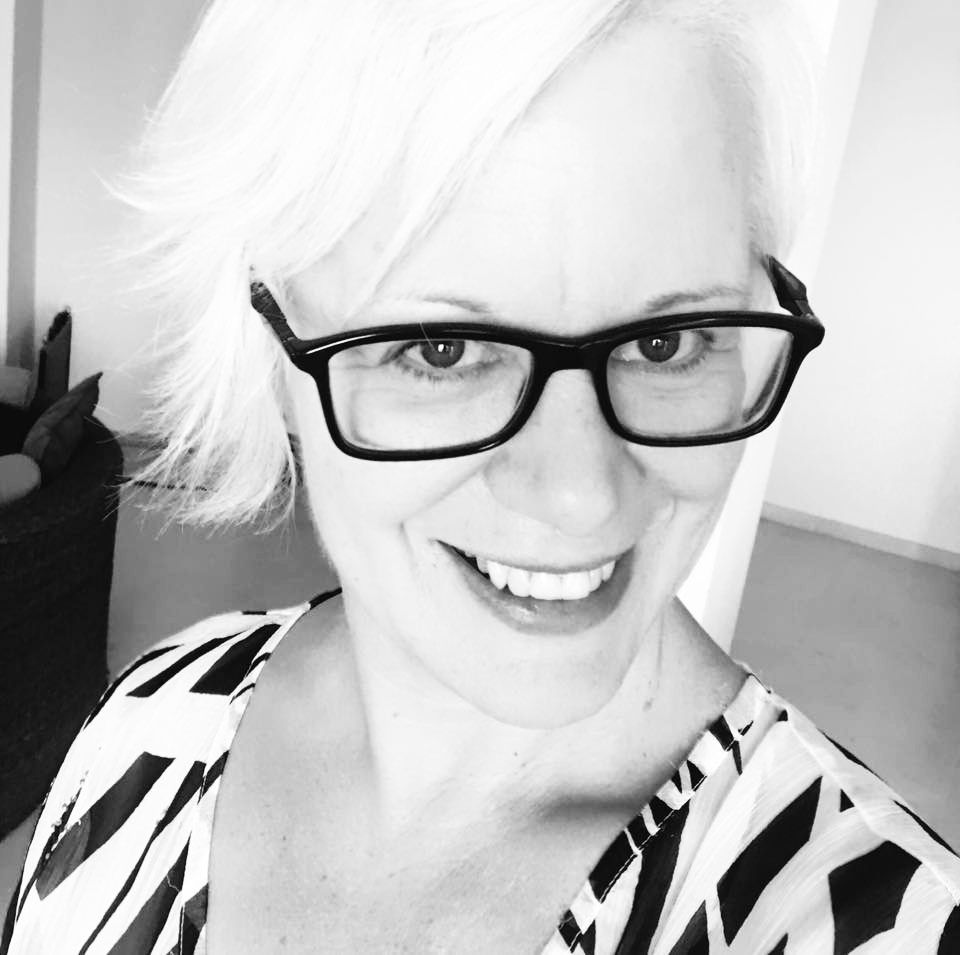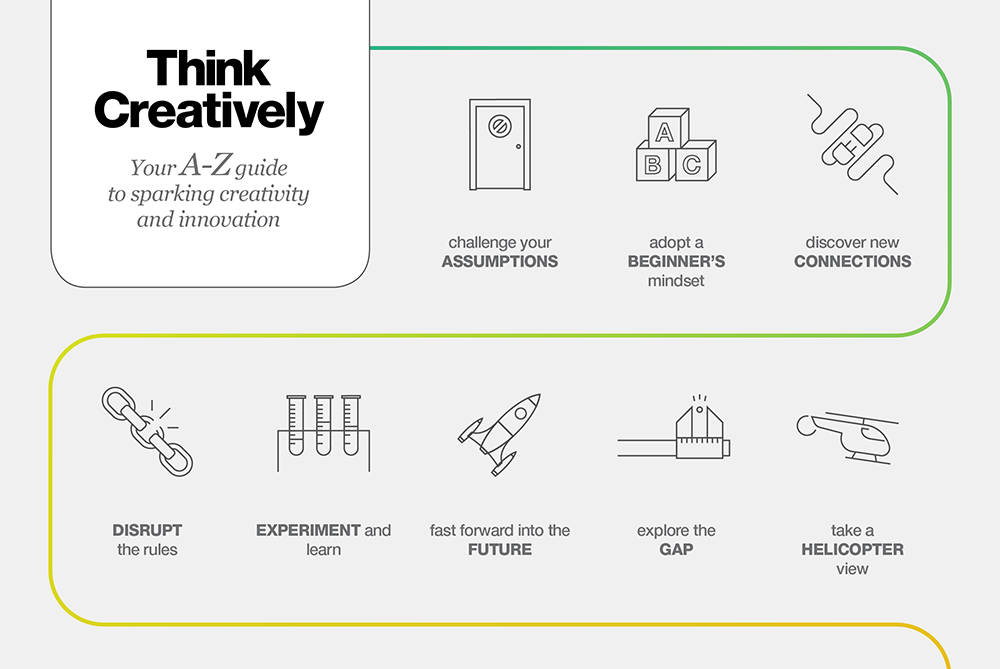We’ve all been there before. You’re up against a problem or a challenge and you just can’t seem to find the way forward.
same thinking = same ideas
Albert Einstein once said, “You cannot solve a problem from the same level of consciousness that created it.” In other words, if you want to come up with fresh and novel ideas for a challenge, you need to disrupt your routine patterns of thinking and provoke your brain’s neuronal pathways to connect differently.
“The difficulty lies not so much in developing new ideas as in escaping from the old ones.” John Maynard Keynes
This ability to make unusual and surprising connections across different areas of knowledge and experience is called “associational thinking,” and according to the Innovator’s DNA, it’s a hallmark talent of highly innovative entrepreneurs and managers.
This A-Z guide gives you 26 creative strategies designed to activate your imagination and get you thinking differently. So if you’re feeling stuck or banging your head against a brick wall, why not put your problem or challenge through each strategy. They’re ideal to use with your team and in brainstorming sessions.
1. Challenge Your ASSUMPTIONS
“Your assumptions are your windows on the world,” says actor Alan Alda. “Scrub them off every once in a while, or the light won’t come in.” When you think about your issue, what assumptions are you making? Make a list and challenge each one of them. Do they really hold true? What new light can you let in?
2. Adopt a BEGINNER’S Mindset
At 3 years old Sofia has a brain like a supercharged engine hungry for learning and creativity. Can you guess what her favourite question is? Why not take a fresh look at the problem you want to solve. Invite your curious inner child out to play and pretend you know nothing. Ask “why?” Or even better, ask “why not?”
3. Discover New CONNECTIONS
As Steve Jobs once said, “creativity is connecting things.” The more you expand your consciousness, the more connection points you can make. Look outside your field and explore other peoples’ successes. What can you learn? What new connections can you make? How can you bring these insights into your current situation?
4. DISRUPT the Rules
Remember the days when you had to actually go into a bookshop to buy a book? Then Amazon came along and changed everything. Take a moment to think about how you might be accepting the status quo and inadvertently conforming to “the way things are done.” What “rules” could you challenge and change?
5. EXPERIMENT and Learn
Thomas Edison didn’t get the lightbulb right first time. In fact he “found 10,000 ways that didn’t work.” Experimenting gives you the chance to fail fast and learn quickly about what works, and what doesn’t. How could you test some of your best concepts on a small scale?
6. Fast Forward into the FUTURE
The great artist, Leonardo da Vinci, was renowned for his ability to imagine the future. He conceptualised designs for the parachute and helicopter centuries before they were even invented. So fast forward to 1 year, 5 years and 20 years from now. What could be possible?
7. Explore the GAP
The gap is the space between where you are today and where you want to be. Filmmaker Jane Campion once said, “If you can stand in the space just for a little while, a new door will open.” So reflect on your situation and explore the gaps. What are the biggest obstacles? What are the greatest fears?
8. Take a HELICOPTER View
Sometimes we get so focused on the trees, that we can’t see the forest. When you can rise above your problem, you’re able to view it in the context of the bigger picture. So think about the wider scale of your life, your job or your company. What is most important? What are the top priorities? How does this perspective change your view of the current challenge?
9. IMAGINE the Ideal
Walt Disney said “If you can dream it you can do it.” And look at what he was able to achieve with a dream and a mouse. Close your eyes and imagine your absolute ideal scenario. What do you see? How do you feel? What are people saying around you? How were you able to achieve this vision? Bring it to life by creating a drawing or collage of pictures.
10. JOIN the Dots
History is full of innovative concepts that were the result of combining existing ideas in novel ways. Dyson did exactly that when he combined a vacuum cleaner with a sawdust cyclone to invent the first bagless vacuum cleaner. Grab some Post-it notes and write or draw one idea on each one. Mix and match them together. How many new and interesting combinations can you discover?
11. Broaden Your KNOWLEDGE
Tunnel vision can stifle creativity. That’s why it took an outsider like Apple to revolutionise an entrenched mobile phone industry with the iPhone. Explore outside your area of expertise to enrich your mind and expand your consciousness. What new trends are emerging? What new topics could you explore? How can you integrate this new knowledge?
12. LISTEN to Feedback
Great ideas rarely emerge fully formed. Feedback helps improve and evolve good ideas into becoming great. Facebook started out as a college website before evolving into a global phenomena some years later. So ask a diverse range of people for feedback. Listen carefully to what they say. Be aware of the words they use. Also notice what they don’t say.
13. Don’t Be Afraid to Make MISTAKES
The fear of making mistakes is a huge stumbling block to creativity and innovation especially in the corporate arena. Yet the humble Post-It Note was a concept that originated from a bad batch of glue. So how can you think big, act small, fail fast and learn rapidly? And what’s the worst that can happen anyway?
14. Let Go of What’s Not NEEDED
The artist Hans Hofmann once said, “The ability to simplify means to eliminate the unnecessary so that the necessary may speak.” Budget airlines have built successful businesses around this philosophy. Minimalistic design has done the same. Google’s home page remains the epitome of a “less is more” approach. So think about the ideas you’ve generated. What is not necessary? How can this be eliminated?
15. Consider the OPPOSITE
Apparently Albert Einstein was able to imagine an object both in motion and at rest at the same time. Being able to hold paradoxes shifts you from an “either/or” mindset to a “both/and” mentality. This blows open the creative spectrum from which fresh ideas can emerge. So consider your challenge. What is the “norm?” What is the opposite of this? How could both hold true?
16. Make a PROTOTYPE
Rapid prototyping has been key to the design and development of our brainsparker app. First we used rough paper mock-ups and then moved on to refined digital screenshots. We shared our prototypes with others, watched how they used them and got their instinctive feedback. How could you do the same to improve and refine your best ideas? Remember your prototypes don’t have to be perfect.
17. QUESTION Everything
Asking questions is the best ways to probe a problem and find the pain points. Take the idea behind Netflix for example, the driving question that co-founder Reed Hastings asked after he was fined $40 for an overdue DVD was, “What if a video rental company didn’t charge late fees?” Think about your situation and brainstorm ideas around these two killer questions; “What if?” and “How might we?”
18. REFRAME the Problem
Imagine a circus performance with no live animals. Cirque du Soleil did. “We didn’t reinvent the circus,” said co-founder Guy Laliberte. “We repackaged it in a much more modern way.” By taking a different perspective they tapped into a plethora of fresh ideas that has made their show a global sensation. So put yourself in the shoes of your user or customer. What is missing for them? How could you deliver this in a new and novel way?
19. Keep Things SIMPLE
The brand name “Skype” comes from an abbreviation of “sky peer-to-peer.” And this describes the essence of the Skype service which hasn’t changed much since it launched in 2003. By keeping things simple, Skype has gone on to attract over 660 million users worldwide. So boil your challenge down to the absolute essence. What is at the heart of the problem? Brainstorm ideas around that. And keep your ideas simple too.
20. TRUST Your Intuition
“Intuition is the wisdom formed by feeling and instinct — a gift of knowing without reasoning,” says top business woman Angela Ahrendts. As such, your intuition can hold a wealth of insight and surprising ideas if you’d only stop and listen to it. When you think of the challenge you’re facing and the ideas you’ve generated, what does your gut feeling say?
21. Explore the UNKNOWN
In 2001, entrepreneur Elon Musk conceptualised “Mars Oasis,” a project to land a miniature greenhouse on Mars containing food crops. But first he needed to buy a rocket. Easier said than done for a space novice such as Musk. In the end he decided to build his own and founded SpaceX with the long-term goal of creating a “true spacefaring civilisation.” In the same way, what unknown could you explore?
22. VISUALISE Success
When Nobel Laureate, Jonas Salk, was asked how he went about inventing the polio vaccine, he replied, “I pictured myself as a virus or a cancer cell and tried to sense what it would be like.” How could you do the same? Just imagine your solution has been incredibly successful. What is happening? What are you doing? What are you seeing? What are people saying? How do you feel?
23. Find the “WOW” Factor
Mills & Boon have been publishing romance novels for over a hundred years, yet it was an unknown self-published author, E. L. James, who hit the best seller list with her “50 Shades of Grey.” For millions of people around the world it has the “WOW” factor. Somehow it has hit an important known (or unknown) need or want. Which of your ideas could really “wow” your user?
24. Apply X-RAY Vision to See Below the Surface
Our emotions play a key role in the decisions we make. One research study even showed that sunny days, which make us feel happy, caused a boost in stock market performance. So look past the surface of “what is” and drill down into “what is the real problem.” Tap into the emotional needs and wants of your users and customers. What fresh ideas can you come up with to satisfy these?
25. Do Things Your WAY
Instagram has just revealed that its top 5 accounts, including Taylor Swift, Beyonce and Kim Kardashian, each have over 40 million followers. What draws people to follow these celebrities is their authentic and very personal updates posted in real-time. You too are unique. Your best creative asset could be the way you see things, the way you think and the way you do things. If you knew you couldn’t fail, what would YOU do?
26. Foster Your Inner ZEN
Brain specialists have found that Theta waves activate your imagination, trigger new ideas and create a feeling calm. That’s why those spontaneous “light bulb” moments often happen when you’re relaxed, in the shower, walking the dog or driving home. So take time to walk in nature, do something repetitive, meditate or simply daydream. And be mindful, you never know when that “aha” moment will arrive.
(click here to view infographic as PDF)
“Nothing is more dangerous than an idea when it is the only one you have.” Emile Chartier
So let’s start an ideas revolution!
Originally published at medium.com


